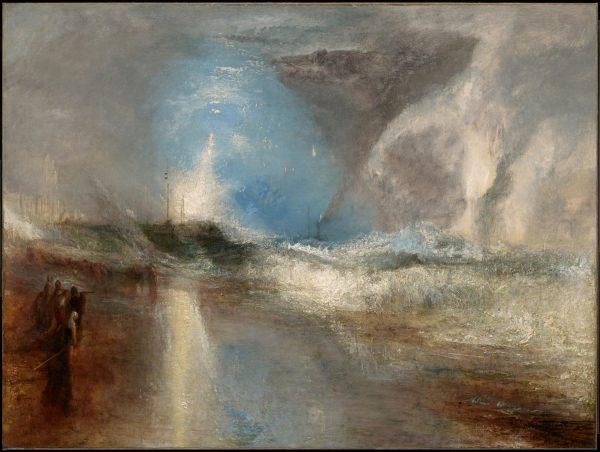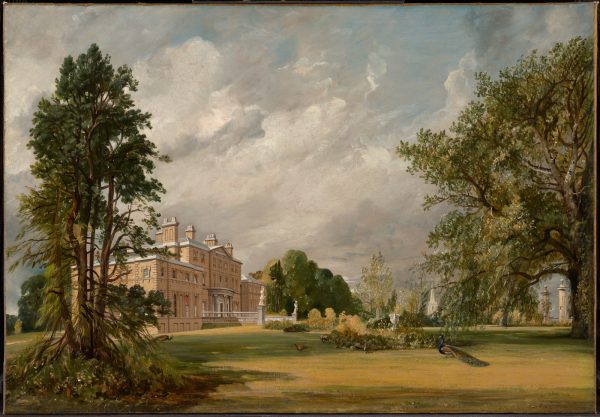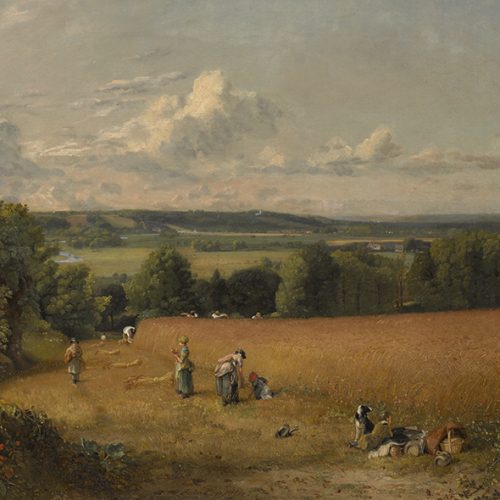Visual Arts Review: The Twin Towers of British Landscape Painting — Compare and Contrast
By Charles Giuliano
One sees how the keen observation and “truth to nature” that critic John Ruskin espoused was put into action by John Constable and J.M. W. Turner.

Joseph Mallord William Turner, “Rockets and Blue Lights (Close at Hand) to Warn Steamboats of Shoal Water” 1840. Clark Art Institute, 1955.37.
Through March 10, the Clark Art Institute is presenting the compact exhibition Turner and Constable: The Inhabited Landscape. Curated by Alexis Goodin, and installed in about a third of the museum’s special exhibition space, this scholarly show offers a thumbnail of the permanent collection.
The project gives viewers an opportunity to compare and contrast the twin towers of British landscape painting: Joseph Mallord William Turner (23 April 1775 – 19 December 1851) and John Constable, (11 June 1776 – 31 March 1837).
There are a few major paintings on display among some fifty works, including plein air as well as studio, oil sketches, watercolors, drawings, and prints. Most intently, one sees how the keen observation and “truth to nature” that critic John Ruskin espoused was put into action by Constable and Turner.
Rightly so, Turner’s late masterpiece “Rockets and Blue Lights (Close at Hand) to Warn Steamboats of Shoal Water,” 1840, is the focal point of this intimate exhibition. Arguably, it is among a handful of the artist’s greatest paintings. The picture depicts the impact of a violent storm; it is based on an event in which beleaguered vessels were dashed on the rocks. The artist’s approach is an abstracted synthesis of nature — unleashed in all of its fury, a frenzy of paint with swaths of foam and spray bursting on rocks. There are few concrete details, but hints of figures can be glimpsed in the left foreground. To the left of a tilted horizon line is a burst of rockets. They have been set off to warn endangered vessels of proximity to the rocks.

John Constable, Malvern Hall, 1821. Clark Art Institute, 1955.683.
Through a combination of cost, availability, and hesitation, Francine and Sterling Clark fared less well in their acquisitions of works by Constable. At one point they were offered one of the painter’s seminal series of views of Salisbury Cathedral. The picture compared well to an example they inspected in the Frick Collection. They passed, and later acquired a lesser version as well as a drawing of the subject. (It is interesting to learn that an ‘expensive’ Constable at that time was valued at some $6,000. Today the prices for those paintings would be measured in millions of dollars.)
The best of the Constables in this exhibition are the quirky “Malvern Hall” and the marvelous but atypical “The Wheat Field.” “Malvern Hall” was a rare commission; it proffers meticulous detail of a grand estate. It has been reported that Francine Clark objected to the ‘ugly’ yellowed lawn — fortunately, she was overruled by her husband. The rightly acclaimed “The Wheat Field” fits the exhibition’s theme nicely (“The Inhabited Landscape”). The image is more populated than one expects from Constable; his works are generally uninhabited or sparsely so. This depiction of a harvesting scene is more like a Barbizon genre painting. One might even think of a scene of peasants by Breugel. “The Wheat Field” comprises three, horizontal, parallel zones. The bottom third depicts a stretch of yellowed, ripe wheat. Small figures can be seen at work. Below the horizon line is an expanse of dark trees and then a glimpse of another field. For the top part of the picture, a signature of the artist, there’s a detailed, sumptuous treatment of sky and clouds.
What Francine Clark objected to in “Malvern Hall” lies at the heart of the issue when it comes to viewing British landscape: gardens, and depictions of them. Evolving from classicism to romanticism, British art reflected a revolution that came with the abandonment of Italianate and French formal gardens. This transformation was begun by Lancelot Capability Brown (1715-1783), who created some 170 gardens and parks. For the critic Sir Uvedale Price, the Picturesque was exactingly defined: it was located between the Beautiful and the Sublime. Brown became known as Capability because he advised clients of how easily their estates were capable of improvement. At issue was the development of British philosophy, landscape design, poetry, and the fine arts, a quarrel sparked by A Philosophical Enquiry into the Origin of Our Ideas of the Sublime and Beautiful, a 1757 treatise by Edmund Burke. (There is a witty exposition of the differences between Brown and Price in Tom Stoppard’s 1993 play Arcadia.)

John Constable, “The Wheat Field” 1816, Gift of the Manton Art Foundation in memory of Sir Edwin and Lady Manton, 2007.
At stake was an emotional contrast in how we respond to the beauty of nature: admiration for the pristine versus more excited reactions to terrifying storms, earthquakes, and natural disasters. In this exhibition, Constable exemplifies valuing the serenity of the beautiful. There is a comforting, picture postcard, calendar quality to his bucolic images. Turner, in contrast, roils viewers with disasters and the forceful violence of nature. Constable never strayed far from home; he emanates a sense of the beloved and familiar. Turner, however, was constantly on the move exploring the continent for exotic subjects. Not surprisingly, Turner became much more celebrated, particularly because he was lauded by Ruskin, who catalogued some 300 Turner paintings and 19,000 drawings.
A curious aesthetic revelation of this project is how, for the most part, their small sketches and studies are more similar than different. This commonality of source material was later incorporated into their signature studio productions. It is intriguing to view what interested them. For Turner we see harbors, bridges, and ruins; in Constable, hamlets, fields, and streams.
They both inspired the next generation of French impressionists, who much admired Constable’s 100 or so cloud studies. The Clarks acquired one of these coveted — and expensive — small works. When he worked in London, Claude Monet looked long and hard at Turner paintings in the Tate. This is particularly evident in his interest in Turner’s bravura, alla prima approaches to métier. Turner built up layers of glazes over time, but he still worked on paintings until “varnishing day.”
While the Clarks collected impressionism in depth, they only “sampled” British landscape. That has now changed at the Clark Institute. The exhibition makes use of the 200 oil paintings, sketches, works on paper, and prints in the Clark’s Manton Collection of British Art. Amassed by the collector Sir Edwin Manton, the works were gifted to the museum by the Manton Art Foundation in 2007. This donation motivated the institution’s unique pairing of British landscape masters. This is the kind of show that’s perfect to take in during a lingering and quietly enriching winter afternoon in the Berkshires.
Charles Giuliano is finishing his sixth book Counter Culture in Boston; 1968 to 1980. It comprises interviews about folk, rock, jazz, media, and radio as well as many vintage images by the author.
Tagged: Charles Giuliano, Clark Art Institute, John Constable, Joseph Mallord William Turner
